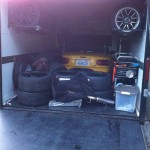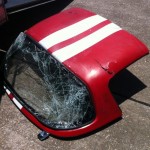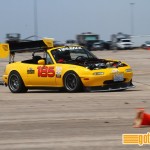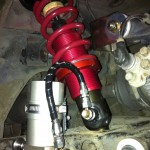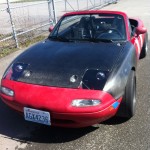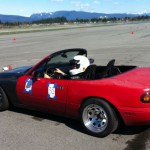I took much of last year off, made some poor suspension choices, and didn’t pay much attention to the car. I got my butt kicked in most events I went to, and wasn’t very happy with the car or my driving. In the end, though, it gave me what I needed — most of a year off. I flew around the country and codrove with the Woottons a few times, autocrossed a bunch of random cars, and had some fun anyway. I also noticed that, despite lots of attention to the car everywhere I posted it for sale, no one even sniffed around at a real offer, so I know that, someday when I do actually sell, parting it out is the way to go.
![1530326_619095470648_962636239_n[1]](http://www.directedconsulting.com/destinationssm/wp-content/uploads/2014/04/1530326_619095470648_962636239_n1-300x225.jpg) For this year, I’m going to make a little more of an effort again. We moved into a new house last year and didn’t have a good way to deal with the towing situation, so this year my dad sold his giant trailer and I bought a tiny little trailer, perfect for a Miata. Most importantly of all, I can back the trailer, with the car on it, into my garage, and leave it there, ready for an event at any time, with the truck parked in front of it. I’m hoping that I’ll find a lot more motivation to autocross when it means spending 5 minutes in the morning and 10 in the evening loading/unloading instead of 2+ hours on each side getting the truck/trailer to/from my parents’.
For this year, I’m going to make a little more of an effort again. We moved into a new house last year and didn’t have a good way to deal with the towing situation, so this year my dad sold his giant trailer and I bought a tiny little trailer, perfect for a Miata. Most importantly of all, I can back the trailer, with the car on it, into my garage, and leave it there, ready for an event at any time, with the truck parked in front of it. I’m hoping that I’ll find a lot more motivation to autocross when it means spending 5 minutes in the morning and 10 in the evening loading/unloading instead of 2+ hours on each side getting the truck/trailer to/from my parents’.
I decided to attack some of my root annoyances with the car as well this year. At the end of last season, I realized that my traction control system was a little flaky. While it often helped, it often cut in when it had no reason to. I spent some time debugging it at the first event this year and learned that it is, in fact, cutting fuel even with the system completely disabled — when I bypass the unit and plug the injectors directly into the ECU, it runs perfectly. I’ve been working with RaceLogic the past couple weeks trying to narrow down what the problem actually is. So far, we think it’s the adjuster unit, but it will require further diagnosis. Until I get that sorted out, the unit is staying fully disconnected, forcing me to learn how to modulate a gas pedal — something I’m not very good at, apparently.
![intake[1]](http://www.directedconsulting.com/destinationssm/wp-content/uploads/2014/04/intake1-300x225.jpg) Another big annoyance was the general tune of the car. In addition to feeling like I didn’t have enough power, there was always a bunch of hiccups in the tune (above and beyond the RaceLogic-induced ones). Throttle pump (tip-in) was always sketchy, leading to unpredictable power levels on corner exit. At 2012 nationals we noticed that underhood temps were crazy, and put a hole in the hood for the intake. Since then, I’d switched back to a more traditional intake, but pulling air from the driver’s side headlight area. I also upgraded to Flyin Miata’s big flex fuel kit, which is a pretty awesome setup, and upgraded to ID1000 injectors in preparation for E85.
Another big annoyance was the general tune of the car. In addition to feeling like I didn’t have enough power, there was always a bunch of hiccups in the tune (above and beyond the RaceLogic-induced ones). Throttle pump (tip-in) was always sketchy, leading to unpredictable power levels on corner exit. At 2012 nationals we noticed that underhood temps were crazy, and put a hole in the hood for the intake. Since then, I’d switched back to a more traditional intake, but pulling air from the driver’s side headlight area. I also upgraded to Flyin Miata’s big flex fuel kit, which is a pretty awesome setup, and upgraded to ID1000 injectors in preparation for E85.
![miatadyno_20140302[1]](http://www.directedconsulting.com/destinationssm/wp-content/uploads/2014/04/miatadyno_201403021-300x242.jpg) Last spring, I changed from an AEM to a Hydra Nemesis for an ECU, and immediately was able to improve the drivability of the car quite a bit. However, it was still far off what I wanted/needed it to be for consistent driving. I gave the car to Kris Osheim of KO Racing early this year and he spent a few weeks road tuning it to help with drivability and low end torque. The car is an entirely different beast now — mashing the gas at 2000 RPMs produces an instant wall of torque, and different rates of tip-in actually produce linearly proportional amounts of power. Using the flex fuel setup, I can now put anything from full pump gas to full E85 or any mix in between, and the car fires right up and makes a safe amount of power for whatever ethanol mix I’m running. The car now makes 359rwhp/279rwtq (Dynojet corrected) on E85 and 316/256 on 92. The old power numbers were falsely inflated by the previous dyno I was using — he applied a fixed 20% correction factor, so this is actually quite a huge bump in power over the old setup.
Last spring, I changed from an AEM to a Hydra Nemesis for an ECU, and immediately was able to improve the drivability of the car quite a bit. However, it was still far off what I wanted/needed it to be for consistent driving. I gave the car to Kris Osheim of KO Racing early this year and he spent a few weeks road tuning it to help with drivability and low end torque. The car is an entirely different beast now — mashing the gas at 2000 RPMs produces an instant wall of torque, and different rates of tip-in actually produce linearly proportional amounts of power. Using the flex fuel setup, I can now put anything from full pump gas to full E85 or any mix in between, and the car fires right up and makes a safe amount of power for whatever ethanol mix I’m running. The car now makes 359rwhp/279rwtq (Dynojet corrected) on E85 and 316/256 on 92. The old power numbers were falsely inflated by the previous dyno I was using — he applied a fixed 20% correction factor, so this is actually quite a huge bump in power over the old setup.
Suspension-wise, I knew I needed to change things. In 2012 I was running 700/450 springs, and based on the math said we should be running 800s in the front, so for the 2013 season I tried just bumping to 800s. Of course, the car went from fairly well balanced to ultra-pushy. I spent the limited season trying to dial it out with shock adjustments, but for 2014 I went up to 550 rear springs and added a small rear swaybar. Two events into the season, the balance of the car is proving to be a huge improvement over last year, which makes it a lot more fun to drive.
The brakes had always been a big complaint of mine with the car — they were a little unpredictable and, especially on concrete, you were essentially unable to bring the car into ABS. For 2013, I upgraded the fronts to Flyin Miata’s little big brake kit with the 11″ rotors, and went to a 1″ 929 master cylinder with a dual diaphragm brake booster, which were a huge improvement. I’ll likely upgrade the rears to their rear little big brake kit this season as well, but I haven’t pulled the trigger on that yet. I’ve also changed out the rear wheel bearings and front hubs for this season, as they were starting to get some play in them noticeable as pad-knockback after hard cornering.
I’m planning on attempting to get the car out to several big events this year — Crow’s Landing, Packwood, Spring Nationals (Lincoln), and Nationals. There’s still a bunch to get working on the car for real — Eric Anderson’s car proves how effective the RaceLogic can be if I can work the demons out of my system, dialing in the new suspension setup, and learning how to drive a car that can break the tires loose at will in a straight line in 2nd gear on Asphalt.
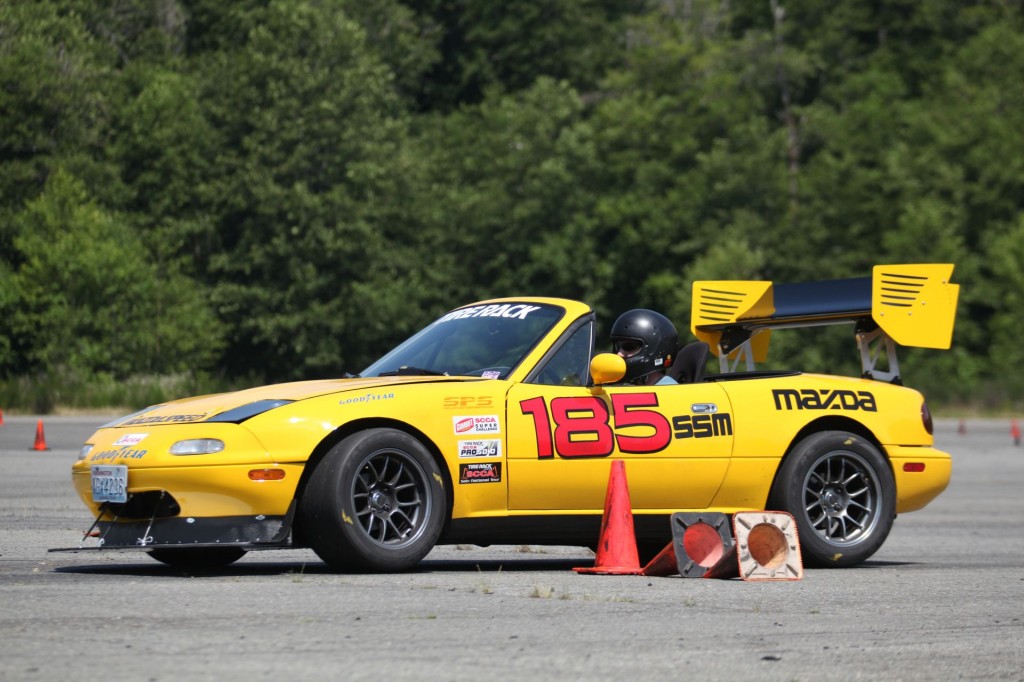

![miatapower330[1]](http://www.directedconsulting.com/destinationssm/wp-content/uploads/2012/07/miatapower3301-150x150.jpg)
